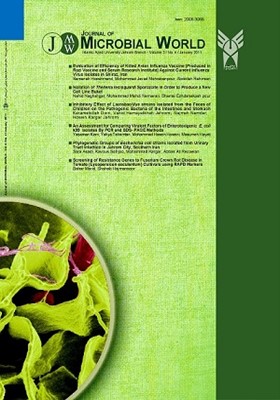Evaluation of efficiency of killed avian influenza vaccine (produced in Razi vaccine and serum research institute) against current influenza virus isolates in Shiraz, Iran
Subject Areas : Medical MicrobiologySamaneh Hooshmand 1 , Mohammad Javad Mehrabanpour 2 * , Abdollah Rahimian 3
1 - Department of Microbiology, Jahrom Branch, Islamic Azad University, Jahrom, Iran
2 - Department of Virology, Razi Vaccine and Serum Research Center, Shiraz, Iran
3 - Department of Virology, Razi Vaccine and Serum Research Center, Shiraz, Iran
Keywords: Influenza virus, killed oil-emulsion vaccine, Avian influenza, and H9N9 Strain,
Abstract :
Background and objective: Influenza virus H9N2 is a low pathogenic avian influenza that its first outbreak in Iran was reported in 1998 and caused appreciable economic losses in the poultry industry. Vaccines are one of applicable approach for protect the avians from avian influenza viruses. This study aimed to evaluate a killed avian influenza vaccine (produced in Razi vaccine and serum research institute) against current isolates in Shiraz. Materials and Methods: In this study, fifty broiler chickens were divided into 5 ten-bird groups including test and control groups. Forty broiler chickens (group 1, 2, 3 and 4) were vaccinated with the killed oil-emulsion influenza vaccine that was obtained from Razi Vaccine and Serum Research Institute. Ten chickens were used as control group (Nonvaccinated group). After two weeks both vaccinated and control chickens were inoculated with H9N2 influenza viruses that were isolated from chickens farms of Shiraz in 2010. The cloacal and tracheal swab samples were collected from chickens at 1,3,5,7,9,11 days after infection and were processed for virus isolation. Results: The results showed that after five days for group 1 and after seven days for groups 2, 3 and 4, virus shedding into tracheal and cloacal samples was significantly decreased. However, the shedding continued for 11 days in control group. Conclusion: The results suggested that the killed oil-emulsion influenza vaccine could efficiently decrease AI replication and its shedding in the broiler chickens.
1. Roussan DA, khassan GY, Rifai RH, Totanji WS, Shaheen IA. Avian influenza virus H9 subtype in poultry flocks in Jordan. Prev Vet Med. 2009; 88(1): 77-81.
2. Kwon HJ, Cho SH, Ahn YJ, Kim JH, Yoo HS, Kim SJ. Characterization of a chicken embryo-adapted H9N2 subtype avian influenza virus. Open Vet Sci J. 2009; 3: 9-16.
3. Mosakhani F. Recogniation of influenza hemagglutinin gene from iranian industerial poultry in the years 1382-1383. MSc Thsis. Islamic Azad University, Science and Research Branch. 2005.
4. Kim MC, Choi JG, Kwon JS, Kang HM, Paek MR, Jeong OM, Kwon JH, Lee YJ. Field application of the H9M2e enzyme-linked immunosorbent assay for differentiation of H9N2 avian influenza virus-infected chickens from vaccinated chicken. Clin Vaccine Immunol. 2010; 17(12): 1977-1984.
5. Rajabi Z, Taif Nasrabadi H, Soyofi Khojin AB. In vitro quality evaluation of avian influenza subtype H9N2 oil-emulsion vaccine. J Vet Res. 2010; 65(4): 295-299. [In Persian].
6. Zamani Moghaddam AK, Bozorgmehri Fard MH, Vasfi Marandi M, Tabatabaii AM. Comparative experiment study of immunogenesis of different inactivated H9N2 avian influeza vaccine in broiler chickens. J Facul Vet Med. 2001; 56(3): 103-107.
7. Vasfi Marandi M, Bozorgmehri Fard MH, Hashemzadeh M. Efficacy of inactivated H9N2 avian influenza vaccine against non-highly pathogenic A/Chicken/Iran/ZMT-173/1999 Infection. Arch Razi Ins. 2002; 53: 23-26.
8. Vervelde L, de Geus E, Jansen C, Heller DE. Contributon of the genetic background to the immune response of broilers vaccinated or challenged with LPI H9N2. BMC Proc. 2011; 5(4): 1-4.
9. Grimes SE . A basic laboratory manual for the small-scale production and testing of I-2 Newcastle disease vaccine. Bangkok: FAO Regional Office for Asia and the Pacific (RAP), 2002.
10. Noroozian H, Vasfi Marandi M, Gorashi SA. Characterization and phylogenetic analysis of neuraminidase gene in isolated avian influenza viruses of H9N2 subtype from Iran. J Vet Res. 2010; 65(4): 311-318. [In Persian].
11. Choi JG, Lee YJ, Kim YJ, Lee EK, Jeong OK, Sung HW, Kim JH, Kwon JH. An inactivated vaccine to control the current H9N2 low pathogenic avian influenza in Korea. J Vet Sci. 2008; 9(1): 67-74.
12. Moghadam Pour M, Momayez R, Akhavizadeghan MA. The efficacy of inactivated oil-emulsion H9N2 avian influenza vaccine. Iran J Vet Res. 2006; 7(2): 85-88.
13. Garcia A, Johnson H, Srivastava DK, Jayawardene DA, Wehr DR, Webster RG. Efficacy of inactivated H5N2 influenza vaccines against lethal A/Chicken/Queretaro/19/95 infection. Avian Dis.1998; 42(2): 248-256.
14. Naeem, K. The avian influenza H7N3 outbreak in South Central Asia. Proceeding of the 4th International Symposium on Avian Influenza, Athens, Georgia. US Animal Health Association. 1998; 31-35.

